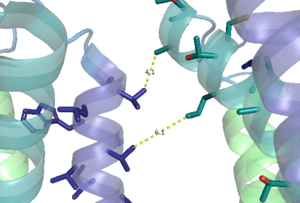Sandbox Reserved 1703
From Proteopedia
(Difference between revisions)
| Line 32: | Line 32: | ||
====G-protein Binding==== | ====G-protein Binding==== | ||
| - | The PAM induced downward shift of helix IV coupled with the reorientation of the transmembrane domain to a TM6-TM6 asymmetric interface, opens up a cleft on the intracellular surface of the receptor. This cleft allows a hook-like region (figure 4), that is composed of the last 4 residues of the alpha subunit of the G-protein, to move in adjacent to helix IV in the transmembrane domain. One very important residue in this interaction is <scene name='90/904308/ | + | The PAM induced downward shift of helix IV coupled with the reorientation of the transmembrane domain to a TM6-TM6 asymmetric interface, opens up a cleft on the intracellular surface of the receptor. This cleft allows a hook-like region (figure 4), that is composed of the last 4 residues of the alpha subunit of the G-protein, to move in adjacent to helix IV in the transmembrane domain. One very important residue in this interaction is <scene name='90/904308/Binding_site/1'>C351</scene> on the hook that participates in hydrophobic interactions with Intracellular loop 2 and helix IV. It is due to these interactions that the C-terminal region of the alpha subunit of the G-protein binds in the shallow groove formed by intracellular loops 2 and 3 and residues on helices lll and lV<ref name="Lin" />.The receptor is now <scene name='90/904308/Active_structure/3'>fully active</scene> with the dimer coupled only to one G-protein, the Venus FlyTrap Domain in the closed conformation resulting in a tighter form, and the transmembrane domain helices reoriented on both the alpha and beta chains to form an asymmetric dimer interface. |
[[Image:Newly labled hook region.png|400 px|left|thumb|'''Figure 4.''' The hook-like region is made up of the last 4 residues on the alpha subunit of the G-protein. Residue C351 hydrophobically interacts with intracellular loop 2 and helix IV. Due to these interactions, the G-protein is able to bind to a shallow groove formed by intracellular loops 2 and 3.]] | [[Image:Newly labled hook region.png|400 px|left|thumb|'''Figure 4.''' The hook-like region is made up of the last 4 residues on the alpha subunit of the G-protein. Residue C351 hydrophobically interacts with intracellular loop 2 and helix IV. Due to these interactions, the G-protein is able to bind to a shallow groove formed by intracellular loops 2 and 3.]] | ||
Revision as of 01:20, 29 March 2022
==Metabotropic Glutamate Receptor 2==
| |||||||||||
References
- ↑ 1.0 1.1 1.2 1.3 1.4 1.5 1.6 1.7 Lin S, Han S, Cai X, Tan Q, Zhou K, Wang D, Wang X, Du J, Yi C, Chu X, Dai A, Zhou Y, Chen Y, Zhou Y, Liu H, Liu J, Yang D, Wang MW, Zhao Q, Wu B. Structures of Gi-bound metabotropic glutamate receptors mGlu2 and mGlu4. Nature. 2021 Jun;594(7864):583-588. doi: 10.1038/s41586-021-03495-2. Epub 2021, Jun 16. PMID:34135510 doi:http://dx.doi.org/10.1038/s41586-021-03495-2
- ↑ Seven, Alpay B., et al. “G-Protein Activation by a Metabotropic Glutamate Receptor.” Nature News, Nature Publishing Group, 30 June 2021, https://www.nature.com/articles/s1586-021-03680-3
- ↑ Zhang, Zhu, et al. “Roles of Glutamate Receptors in Parkinson's Disease.” MDPI, Multidisciplinary Digital Publishing Institute, 6 Sept. 2019, https://dx.doi.org/10.3390%2Fijms20184391.>
- ↑ Yang, Hong-Ju, et al. “Deletion of Type 2 Metabotropic Glutamate Receptor Decreases Sensitivity to Cocaine Reward in Rats.” Cell Reports, U.S. National Library of Medicine, 11 July 2017, https://www.ncbi.nlm.nih.gov/pmc/articles/PMC5555082/.>
- ↑ 5.0 5.1 Du, Juan, et al. “Structures of Human mglu2 and mglu7 Homo- and Heterodimers.” Nature News, Nature Publishing Group, 16 June 2021, https://www.nature.com/articles/s41586-021-03641-w.>
Student Contributors
Frannie Brewer and Ashley Wilkinson




